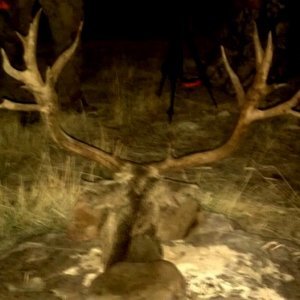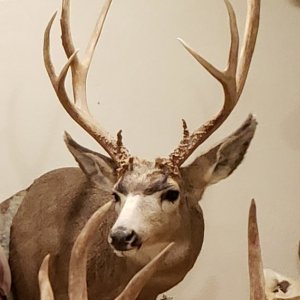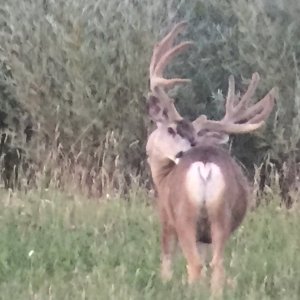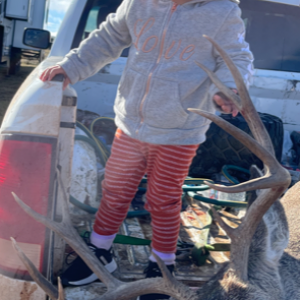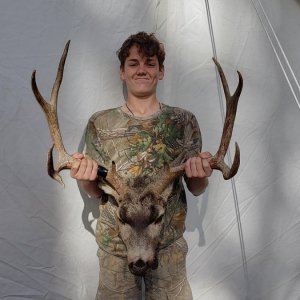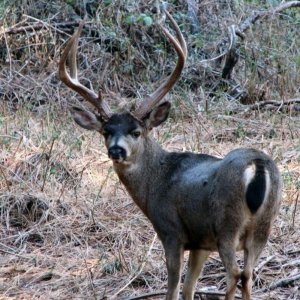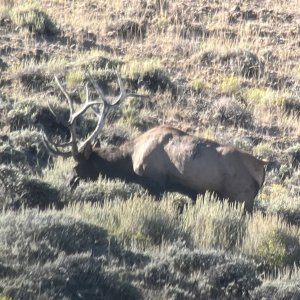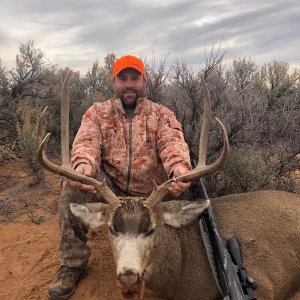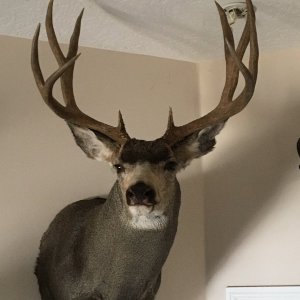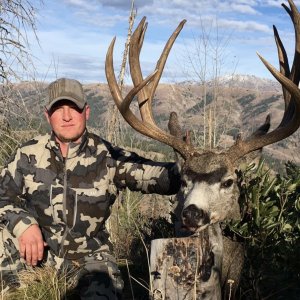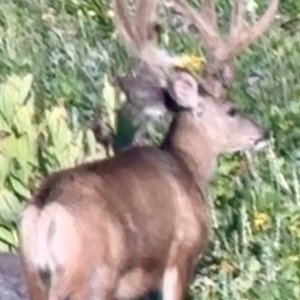2lumpy
Long Time Member
- Messages
- 8,529
LAST EDITED ON Mar-20-10 AT 04:27AM (MST)[p]Last night on a post I titled: "Loosing Opportunity Makes Me Sick" I promised I would post some information regarding my beliefs concerning hunting pressure and harvest and it's effect on the health of our mule deer herds.
The following is a letter I wrote a while back and sent to a individual I thought might be able to do something about an article published in Utah DWR Magazine. I was and continue to be frustrated with the beliefs expressed regarding the effect hunting pressure has on our mule deer population. I believe carefully controlling hunting pressure is most likely the single most important factor to control if we ever hope to have a mule deer recovery in the Western US and especially Utah. I am confident that those that want to maintain and/or increase opportunity will find plenty of reasons to explain away my beliefs and that's okay, I recognized the consequence of posting this on MM.
Read it if you wish and then do your own research. Apply your own common sense and analyze your own experiences then can decide who is correct. Go to the whitetail deer research sites at Mississippi State Univ, Auburn Univ and others and read their studies. Call the research scientists and ask them questions yourself. A great source for mule deer research is Dr. Terry Messmer at our own Utah State Univ. I'm sure he would be more than happy to share his knowledge and beliefs with anyone that cares to ask.
I would like to add this comment, it has been over twenty years ago that I spoke with Dr. Keith Causey from Auburn University. I have quoted him in my comments, these are to the best of my recollection his remarks, it not my intent to misrepresent him or his research, I'm sure he too would be happy to visit with you if you call him, as I did many years ago.
At any rate, you may wish to scroll to the bottom and read the portion of the Utah DWR Magazine article that discusses mule deer before you read my remarks, it might help put my beliefs in context.
Dear xxxxx,
I don't have any idea who Alan Clark is, hopefully you do. I happened upon this article on Monster Muley this evening and was floored once again with the DWR publishing for public consumption the utter nonsense related to mule deer buck doe ratio issues as it effect's herd?s health and the State's mule deer management logic. It could explain why our mule deer populations continue to languish. It is especially troublesome if Mr. Clarks beliefs represent the DWR?s beliefs with regards to Mr. Clarks article and I would have to assume they do in as much as the article was written for and published in the DWR?s magazine. Mr. Clark states that he teaches students at our Universities these concepts and it could explain why our young biologists continue to recommend the kind of management tools we are still using on mule deer in Utah. My guess is these concepts were taught to Mr. Clark by his professors some thirty years ago and he continues to teach them as fact. What's more the hunting public continues to worry about our declining deer populations and yet continue to argue that buck/doe ratios have little or nothing to do with the condition of our herds and continue to press for more and more buck hunting opportunity believing what they have been told by our wildlife professionals. Is it any wonder we keep hitting a brick wall when it comes to mule deer recovery.
Now then to the matter of Mr. Clarks comments.
While 5 buck per hundred doe may in fact breed 100 does that is only part of a much larger and more important factor when it comes to fawn recruitment and fawn recruitment is sole and single natural factor when it come to mule deer population.
There is little evidence that 5 bucks can find and service 100 does in the few days in November when the doe are in heat, a wild and dispersed herd is much different than a penned group of animals. To the contrary, there is significant evident that 5 bucks or even 10 to 15 cannot bred a 100 does in November. They may by the end of December or January but not by the end of November. November is the linch pin, I'll explain.
A doe that doesn't get bred in Nov. doesn't come in heat again until Dec. A doe getting bred in Dec will fawn in mid-July rather than mid-June or mid-Aug if she's bred in January.
Just to clarify a little for the young folks. When a doe goes into estrus somewhere between about November 10 through November 20, in Utah, she only allows a buck to mate for a period of about 48 to 72 hours. If there aren't enough bucks in the population to mate with her during those few hours, she goes out of estrus and does not come back in for about 29 to 30 days. There is a very narrow window for the ideal breeding period, especially when you consider the consequences of getting breed a month or even two months late.
So what?
According to scientific studies done at Auburn Univ. and Mississippi State back in the 1980's wildlife scientists learned that evolution has caused fawns to be born in mid-June for a very, very, very important reason. In order for a fawn to survive even the most mild winter it needs a maximum percentage of body fat. A fawn?s body fat depends almost entirely on the protein content of their mother's milk during the first two months of it's life. The highest protein comes from the fresh new growth of the forage a wild deer eats during the months of June and July. (Remember this is scientific research, not my research.) A fawn born in mid-July or later get less protein from it's mother's milk than a fawn born in mid-June. This is because the forage is older and drier, thus lowering the protein content of the doe's milk. (Does getting bred in December or January (due to low buck doe ratios would account for why we see so many fawns of different sizes during the deer hunt and later in the rut.) If body fat and bone mass are the key ingredient a deer uses to grow antlers it would also explain why we currently see so many spike bucks, rather than genetic mutants they are simply yearlings that have been starved for protein due to poor protein content in their mothers milk.)
So, while it is true, fawn count in the fall, after the deer hunts are over, can show acceptable fawn recruitment but any fawn born late, that goes into the winter with less than optimum body fat most likely dies or become easy prey for predation in the early spring due to it's weakened condition, caused by late summer birth. So in fact Mr. Clark has not lied but I believe he has only told a small portion of the big picture in his attempt to sell the public on lower buck doe ratios. For all I know Mr. Clark believes exactly what he wrote.
What good does it do the deer herd if every doe gets bred as this article points out but low ratios cause or help to cause disastrous fawn recruitment the following spring. Far too many of the fawns counted in the fall and early winter got a late birth and in reality are the walking dead.
According to Dr. Keith Causey from Auburn Univ. buck doe ratio in the State of Alabama got so low (4 to 6 buck per hundred doe) in the early 1980's that they were recording fawn births in every month of the year.
A question no one has every answered for me is this: Once a doe starts a cycle of giving birth a month late, due to being bred a month late, does she every get back on a normal rut cycle or is she doomed to always come into heat for the first time in Dec rather than in Nov. from that time on? I'm sure someone knows the answer but know one I've ever asked can say for sure.
Lets did another event to the history of Utah?s mule deer decline. During the 1940 and 1950 Utah had so many deer they were over eating their habitat and there was great fear they would eventually starve themselves to death through over population. Utah advertised heavily in California for hunters to come and hunt deer. They claim in the 1950 it was legal to harvest three or four deer a year. During this period the doe to fawn ratios reached as high as 120 fawn per hundred does. Even as last as the 1970 fawn/doe ratios where in the 80/100 range. A huge number things have evolved since this period, as I have pointed out in my last post. However there was change in hunting regulations that may have accidentally caused much of the problem we have today with declining herds.
During the 1950 and 1960 hunters poured into Utah in droves and because it was Utah?s intent to reduce the over all numbers of deer, shooting does was legal. As the late 1960 rolled around the hunter impact on deer numbers was beginning to alarm a lot of the Utah sportsmen. Attempts were made to get the DWR to regulate the deer hunt and stop the harvest of doe deer. They were unsuccessful and it was not until a determined sportsman from Monroe, Utah got himself elected to the State Legislature and threatened the DWR with Legislative law that they relented and Utah went to buck only hunting, with short or no seasons on doe deer. At the time this seemed like it would save our deer herds. Also, during this period of time buck/doe ratios where high because many folks just shot a doe or two for meat and went home happy, leaving a high buck/doe ratio.
However, as the years went on the buck only hunting regulations began to reduce the buck/doe ratio and by the early 1980?s many areas in Central Utah and else where had buck/doe ratios under 4 buck per hundred doe. And our fawn/doe ratios had fallen to as low and 35 to 40 fawn per hundred doe and we were all blaming high predator populations (and to some extent I believe the outlawing of 1080 poison in the 1950 did allow populations of cougars, coyotes and eagles to explode). However I have noticed something else as we have tried to reduce predator populations, especially cougars and coyotes on some of our deer units and it is this: as we have removed large number of predators the fawn recruitment hasn't improved. Why would that be, if they are the sole cause of the decline? Why haven't deer herds rebounded as the predator population goes down? Could it be that the buck/doe ratios have continued to remain too low for timely November breeding and even though predators aren't taking the fawns, they are simply dying for lack of body fat and predators are just consuming them as they drop? Consider how easy it would be for an already weakened fawn, a fawn born in July rather than June to be easy prey during March and April of most winters.
Something besides highways, optics, professional guides is keeping our fawn recruitment unnaturally low. I contend it's low buck/doe ratios. Low buck doe ratios that are a DIRECT RESULT OF OVER HARVESTING THE MALES.
Now, consider the exhaustion factor associated with 5 to 10 bucks racing around for three months attempting to bred a 100 does that are not going out of estrus when they should and then consider how vulnerable those few bucks are to disease, starvation and predation in that exhausted condition, then throw in a drought or a harsh winter every few years.
I'd like to reiterate this point some more if you'll allow me.
In wild populations a low buck doe ratio causes a buck to attempt to bred 2 or even 3 times more does that they would in a natural buck doe ratio of somewhere near 45 to 55 buck for every 50 does. (we can argue 30 to 40, the concepts is the same) It take energy to find, compete for, and service a female. Ever attempt, successful or not drains a little more energy, a little more body fat, a few more bumps and bruises for a buck. Then, to continue this frantic activity on through a colder Dec and maybe even into the dead of winter in January in some cases. It absolutely stacks the odd against a buck's survival chances. In the wild kingdom, a single doe in heat causes every buck in the population to expend energy, so if a single doe goes into Dec or January in heat, every buck that can smell her is on a fast trot to service her. The combat between the bucks is increased because you now have fewer does in heat (because some go bred in November) thereby concentrating the few bucks into a tighter more combative environment. We know that bucks are most vulnerable after a normal rut let alone after a 60 to 90 day frenzy. They are easier prey, they are less tolerate to cold weather conditions in Jan and Feb and if we get a later winter storm, just before green up, their dead, even if they were fat and robust when the rut began.
The last time we fought the DWR's attitude, in public, was when we were pounding them on low buck doe ratios back in 1984 and 1985 and the only evidence they could provide that 5 buck per hundred doe could service all the does was a study that had been done on domestic sheep. Where is the new data that supports Mr. Clark/DWR current statement as per this article.
What makes me crazy is it seems our agency people, who carry with them a assumed mantle of responsibility for integrity and honesty, only tell enough of the facts so as to distort the uninformed person?s understanding of an issue. Even the brightest among us repeat these explanations because they trust what the agencies tell us and do not investigate beyond what's been repeated by others that are either misinformed or deceived intentionally.
I know I'm whining to the wrong person but I am 100% certain that complaining to anyone else would amount to going out on my back porch and screaming at the widow next door. If there is something you can do to correct this belief or this apparent attempt at misrepresentation I would appreciate it.
For all I know Mr. Clark was taught this in college or his supervisor explained it to him. he certainly can not have done any independent research on the subject and still write such an article. I've included part of the article below. The rest of the article is regarding elk so I didn't include it.
DC
HERE IS THE SECTION OF MR. CLARKS ARTICLE THAT MAKES ME CRAZY.
Wildlife Management 101
By Alan Clark - Wildlife Section Chief of Wildlife Review Magazine
Published in Utah DWR Magazine -- Wildlife Review: http://wildlife.utah.gov
I've been a wildlife biologist for more than 30 years, and now my daughter is studying to be one too. She often asks me questions about why we hunt certain species the way we do. I'm frequently asked the same questions when I meet with people at events around the state of Utah or when I speak to a wildlife class at a university.
The interactions have helped me realize that people who are not directly involved in managing wildlife have many questions and assumptions about why we manage wildlife the way we do. I thought it would be interesting to address a few of these questions in this issue of Wildlife Review.
Why do we have separate hunts for buck and antlerless deer?
Management recommendations for Utah's mule deer are directly by the objectives in the Mule Deer Management Plan. The plan sets a population (quantity) objective for a total of 412,000 deer statewide by 2011. The plan also outlines a buck-to-doe ratio (quality) objective that guides the number of bucks (males) versus does (females, or antlerless deer). In most areas of the state, we're managing the herds so the ratio of bucks per 100 does is a minimum of 15 bucks per 100 does when the hunting seasons end in the fall.
To achieve those objectives, there are two types of deer hunts each year. The Utah Wildlife Board, with recommendations from division biologists, sets the number of permits for each of these hunts each year.
The buck-hunting season helps achieve the desired buck-to-doe ratio, while the anterless hunt moves the deer herds toward the total population objective. The reason two hunts are needed is tied to deer biology.
Bucks typically make up less than 15 percent of the total population. Since only five bucks per 100 does are needed to successfully breed all of the 100 does, the number of bucks in the population has little effect on the number of fawns born the next year. Even if half of the bucks in a population were harvested, for example, the total population would only be reduced by 5 to 10 percent.
So even when a total deer population is below objective, and we want that population to grow, we can continue to provide hunting opportunity for the "surplus" bucks in the population with little effect on the growth of the deer herd. For this reason, the buck-hunting season helps us adjust the buck-to-doe ratio, but does not have a major impact on the total population.
The anterless hunt produces a different result. When a doe is taken, both doe and the fawns she would have had in the future are removed for the population, which is a much bigger effect on the total population. For this reason, antlerless hunts are designed to get the total population to our objective.
IT'S NEARLY SUN UP SO I'LL LEAVE THIS WITH YOU FOR NOW, I'M INTERESTED IN YOUR OBSERVATIONS AS WELL.
DC
The following is a letter I wrote a while back and sent to a individual I thought might be able to do something about an article published in Utah DWR Magazine. I was and continue to be frustrated with the beliefs expressed regarding the effect hunting pressure has on our mule deer population. I believe carefully controlling hunting pressure is most likely the single most important factor to control if we ever hope to have a mule deer recovery in the Western US and especially Utah. I am confident that those that want to maintain and/or increase opportunity will find plenty of reasons to explain away my beliefs and that's okay, I recognized the consequence of posting this on MM.
Read it if you wish and then do your own research. Apply your own common sense and analyze your own experiences then can decide who is correct. Go to the whitetail deer research sites at Mississippi State Univ, Auburn Univ and others and read their studies. Call the research scientists and ask them questions yourself. A great source for mule deer research is Dr. Terry Messmer at our own Utah State Univ. I'm sure he would be more than happy to share his knowledge and beliefs with anyone that cares to ask.
I would like to add this comment, it has been over twenty years ago that I spoke with Dr. Keith Causey from Auburn University. I have quoted him in my comments, these are to the best of my recollection his remarks, it not my intent to misrepresent him or his research, I'm sure he too would be happy to visit with you if you call him, as I did many years ago.
At any rate, you may wish to scroll to the bottom and read the portion of the Utah DWR Magazine article that discusses mule deer before you read my remarks, it might help put my beliefs in context.
Dear xxxxx,
I don't have any idea who Alan Clark is, hopefully you do. I happened upon this article on Monster Muley this evening and was floored once again with the DWR publishing for public consumption the utter nonsense related to mule deer buck doe ratio issues as it effect's herd?s health and the State's mule deer management logic. It could explain why our mule deer populations continue to languish. It is especially troublesome if Mr. Clarks beliefs represent the DWR?s beliefs with regards to Mr. Clarks article and I would have to assume they do in as much as the article was written for and published in the DWR?s magazine. Mr. Clark states that he teaches students at our Universities these concepts and it could explain why our young biologists continue to recommend the kind of management tools we are still using on mule deer in Utah. My guess is these concepts were taught to Mr. Clark by his professors some thirty years ago and he continues to teach them as fact. What's more the hunting public continues to worry about our declining deer populations and yet continue to argue that buck/doe ratios have little or nothing to do with the condition of our herds and continue to press for more and more buck hunting opportunity believing what they have been told by our wildlife professionals. Is it any wonder we keep hitting a brick wall when it comes to mule deer recovery.
Now then to the matter of Mr. Clarks comments.
While 5 buck per hundred doe may in fact breed 100 does that is only part of a much larger and more important factor when it comes to fawn recruitment and fawn recruitment is sole and single natural factor when it come to mule deer population.
There is little evidence that 5 bucks can find and service 100 does in the few days in November when the doe are in heat, a wild and dispersed herd is much different than a penned group of animals. To the contrary, there is significant evident that 5 bucks or even 10 to 15 cannot bred a 100 does in November. They may by the end of December or January but not by the end of November. November is the linch pin, I'll explain.
A doe that doesn't get bred in Nov. doesn't come in heat again until Dec. A doe getting bred in Dec will fawn in mid-July rather than mid-June or mid-Aug if she's bred in January.
Just to clarify a little for the young folks. When a doe goes into estrus somewhere between about November 10 through November 20, in Utah, she only allows a buck to mate for a period of about 48 to 72 hours. If there aren't enough bucks in the population to mate with her during those few hours, she goes out of estrus and does not come back in for about 29 to 30 days. There is a very narrow window for the ideal breeding period, especially when you consider the consequences of getting breed a month or even two months late.
So what?
According to scientific studies done at Auburn Univ. and Mississippi State back in the 1980's wildlife scientists learned that evolution has caused fawns to be born in mid-June for a very, very, very important reason. In order for a fawn to survive even the most mild winter it needs a maximum percentage of body fat. A fawn?s body fat depends almost entirely on the protein content of their mother's milk during the first two months of it's life. The highest protein comes from the fresh new growth of the forage a wild deer eats during the months of June and July. (Remember this is scientific research, not my research.) A fawn born in mid-July or later get less protein from it's mother's milk than a fawn born in mid-June. This is because the forage is older and drier, thus lowering the protein content of the doe's milk. (Does getting bred in December or January (due to low buck doe ratios would account for why we see so many fawns of different sizes during the deer hunt and later in the rut.) If body fat and bone mass are the key ingredient a deer uses to grow antlers it would also explain why we currently see so many spike bucks, rather than genetic mutants they are simply yearlings that have been starved for protein due to poor protein content in their mothers milk.)
So, while it is true, fawn count in the fall, after the deer hunts are over, can show acceptable fawn recruitment but any fawn born late, that goes into the winter with less than optimum body fat most likely dies or become easy prey for predation in the early spring due to it's weakened condition, caused by late summer birth. So in fact Mr. Clark has not lied but I believe he has only told a small portion of the big picture in his attempt to sell the public on lower buck doe ratios. For all I know Mr. Clark believes exactly what he wrote.
What good does it do the deer herd if every doe gets bred as this article points out but low ratios cause or help to cause disastrous fawn recruitment the following spring. Far too many of the fawns counted in the fall and early winter got a late birth and in reality are the walking dead.
According to Dr. Keith Causey from Auburn Univ. buck doe ratio in the State of Alabama got so low (4 to 6 buck per hundred doe) in the early 1980's that they were recording fawn births in every month of the year.
A question no one has every answered for me is this: Once a doe starts a cycle of giving birth a month late, due to being bred a month late, does she every get back on a normal rut cycle or is she doomed to always come into heat for the first time in Dec rather than in Nov. from that time on? I'm sure someone knows the answer but know one I've ever asked can say for sure.
Lets did another event to the history of Utah?s mule deer decline. During the 1940 and 1950 Utah had so many deer they were over eating their habitat and there was great fear they would eventually starve themselves to death through over population. Utah advertised heavily in California for hunters to come and hunt deer. They claim in the 1950 it was legal to harvest three or four deer a year. During this period the doe to fawn ratios reached as high as 120 fawn per hundred does. Even as last as the 1970 fawn/doe ratios where in the 80/100 range. A huge number things have evolved since this period, as I have pointed out in my last post. However there was change in hunting regulations that may have accidentally caused much of the problem we have today with declining herds.
During the 1950 and 1960 hunters poured into Utah in droves and because it was Utah?s intent to reduce the over all numbers of deer, shooting does was legal. As the late 1960 rolled around the hunter impact on deer numbers was beginning to alarm a lot of the Utah sportsmen. Attempts were made to get the DWR to regulate the deer hunt and stop the harvest of doe deer. They were unsuccessful and it was not until a determined sportsman from Monroe, Utah got himself elected to the State Legislature and threatened the DWR with Legislative law that they relented and Utah went to buck only hunting, with short or no seasons on doe deer. At the time this seemed like it would save our deer herds. Also, during this period of time buck/doe ratios where high because many folks just shot a doe or two for meat and went home happy, leaving a high buck/doe ratio.
However, as the years went on the buck only hunting regulations began to reduce the buck/doe ratio and by the early 1980?s many areas in Central Utah and else where had buck/doe ratios under 4 buck per hundred doe. And our fawn/doe ratios had fallen to as low and 35 to 40 fawn per hundred doe and we were all blaming high predator populations (and to some extent I believe the outlawing of 1080 poison in the 1950 did allow populations of cougars, coyotes and eagles to explode). However I have noticed something else as we have tried to reduce predator populations, especially cougars and coyotes on some of our deer units and it is this: as we have removed large number of predators the fawn recruitment hasn't improved. Why would that be, if they are the sole cause of the decline? Why haven't deer herds rebounded as the predator population goes down? Could it be that the buck/doe ratios have continued to remain too low for timely November breeding and even though predators aren't taking the fawns, they are simply dying for lack of body fat and predators are just consuming them as they drop? Consider how easy it would be for an already weakened fawn, a fawn born in July rather than June to be easy prey during March and April of most winters.
Something besides highways, optics, professional guides is keeping our fawn recruitment unnaturally low. I contend it's low buck/doe ratios. Low buck doe ratios that are a DIRECT RESULT OF OVER HARVESTING THE MALES.
Now, consider the exhaustion factor associated with 5 to 10 bucks racing around for three months attempting to bred a 100 does that are not going out of estrus when they should and then consider how vulnerable those few bucks are to disease, starvation and predation in that exhausted condition, then throw in a drought or a harsh winter every few years.
I'd like to reiterate this point some more if you'll allow me.
In wild populations a low buck doe ratio causes a buck to attempt to bred 2 or even 3 times more does that they would in a natural buck doe ratio of somewhere near 45 to 55 buck for every 50 does. (we can argue 30 to 40, the concepts is the same) It take energy to find, compete for, and service a female. Ever attempt, successful or not drains a little more energy, a little more body fat, a few more bumps and bruises for a buck. Then, to continue this frantic activity on through a colder Dec and maybe even into the dead of winter in January in some cases. It absolutely stacks the odd against a buck's survival chances. In the wild kingdom, a single doe in heat causes every buck in the population to expend energy, so if a single doe goes into Dec or January in heat, every buck that can smell her is on a fast trot to service her. The combat between the bucks is increased because you now have fewer does in heat (because some go bred in November) thereby concentrating the few bucks into a tighter more combative environment. We know that bucks are most vulnerable after a normal rut let alone after a 60 to 90 day frenzy. They are easier prey, they are less tolerate to cold weather conditions in Jan and Feb and if we get a later winter storm, just before green up, their dead, even if they were fat and robust when the rut began.
The last time we fought the DWR's attitude, in public, was when we were pounding them on low buck doe ratios back in 1984 and 1985 and the only evidence they could provide that 5 buck per hundred doe could service all the does was a study that had been done on domestic sheep. Where is the new data that supports Mr. Clark/DWR current statement as per this article.
What makes me crazy is it seems our agency people, who carry with them a assumed mantle of responsibility for integrity and honesty, only tell enough of the facts so as to distort the uninformed person?s understanding of an issue. Even the brightest among us repeat these explanations because they trust what the agencies tell us and do not investigate beyond what's been repeated by others that are either misinformed or deceived intentionally.
I know I'm whining to the wrong person but I am 100% certain that complaining to anyone else would amount to going out on my back porch and screaming at the widow next door. If there is something you can do to correct this belief or this apparent attempt at misrepresentation I would appreciate it.
For all I know Mr. Clark was taught this in college or his supervisor explained it to him. he certainly can not have done any independent research on the subject and still write such an article. I've included part of the article below. The rest of the article is regarding elk so I didn't include it.
DC
HERE IS THE SECTION OF MR. CLARKS ARTICLE THAT MAKES ME CRAZY.
Wildlife Management 101
By Alan Clark - Wildlife Section Chief of Wildlife Review Magazine
Published in Utah DWR Magazine -- Wildlife Review: http://wildlife.utah.gov
I've been a wildlife biologist for more than 30 years, and now my daughter is studying to be one too. She often asks me questions about why we hunt certain species the way we do. I'm frequently asked the same questions when I meet with people at events around the state of Utah or when I speak to a wildlife class at a university.
The interactions have helped me realize that people who are not directly involved in managing wildlife have many questions and assumptions about why we manage wildlife the way we do. I thought it would be interesting to address a few of these questions in this issue of Wildlife Review.
Why do we have separate hunts for buck and antlerless deer?
Management recommendations for Utah's mule deer are directly by the objectives in the Mule Deer Management Plan. The plan sets a population (quantity) objective for a total of 412,000 deer statewide by 2011. The plan also outlines a buck-to-doe ratio (quality) objective that guides the number of bucks (males) versus does (females, or antlerless deer). In most areas of the state, we're managing the herds so the ratio of bucks per 100 does is a minimum of 15 bucks per 100 does when the hunting seasons end in the fall.
To achieve those objectives, there are two types of deer hunts each year. The Utah Wildlife Board, with recommendations from division biologists, sets the number of permits for each of these hunts each year.
The buck-hunting season helps achieve the desired buck-to-doe ratio, while the anterless hunt moves the deer herds toward the total population objective. The reason two hunts are needed is tied to deer biology.
Bucks typically make up less than 15 percent of the total population. Since only five bucks per 100 does are needed to successfully breed all of the 100 does, the number of bucks in the population has little effect on the number of fawns born the next year. Even if half of the bucks in a population were harvested, for example, the total population would only be reduced by 5 to 10 percent.
So even when a total deer population is below objective, and we want that population to grow, we can continue to provide hunting opportunity for the "surplus" bucks in the population with little effect on the growth of the deer herd. For this reason, the buck-hunting season helps us adjust the buck-to-doe ratio, but does not have a major impact on the total population.
The anterless hunt produces a different result. When a doe is taken, both doe and the fawns she would have had in the future are removed for the population, which is a much bigger effect on the total population. For this reason, antlerless hunts are designed to get the total population to our objective.
IT'S NEARLY SUN UP SO I'LL LEAVE THIS WITH YOU FOR NOW, I'M INTERESTED IN YOUR OBSERVATIONS AS WELL.
DC


